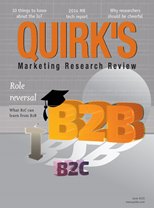Editor's note: Jake Wolff is managing director, North America, at research company Cint, New York.
Fuelled by tech firms that are not focusing on complex methodology, researchers are gathering quick insights and current data. Tech start-ups have moved rapidly into the marketing research arena, facilitating easier access to quick surveys through innovative platforms and tools that include support for mobile-based research. These tech firms specialize in helping companies draw insights from available data via unique technology-based solutions. By replacing manual processes with technology in the MR supply chain, firms hope to help researchers obtain pinpoint data and also provide time efficiencies and cost-savings.
As this trend evolves, the pressure on existing delivery models will grow. Quality checks and other steps involved in deploying and delivering surveys will become increasingly automated. The application of technology in the market research industry, coupled with the need for speed and a thirst for immediately-actionable insights, means that a large and growing group of MR clients are emerging that do not fit within the traditional MR model.
The need for traditional surveys and data analytics will never disappear but the recent trend – coming largely from the U.S. – has been toward gathering fast responses to a limited number of questions to quickly ascertain opinions. This has been driven by a number of players, Google being perhaps the most prominent. With these platforms, business or marketing decisions can be made quickly based on the up-to-date data and insights.
So what effect is this having on the industry? This need for speed inevitably impacts the way client services teams operate and deliver while catering to new demands. Automation is replacing once manual processes and researchers are looking for:
- technology to permit them to program their own surveys;
- technology to speed questionnaire testing, enabling studies to launch more quickly;
- Web or app-based functionality;
- technology to automate the process that determines the median time for the interview (LOI) and IR metrics so that sample and study re-pricing can be done in real time; and
- access to additional sample sources and source types in real-time, so field times aren’t compromised.
Researchers are looking for faster delivery and more current and focused data, removing the requirement for much of the existing human intervention. This is becoming a key factor in MR and will only continue as the automation of many time-consuming steps creates further efficiencies in the supply chain.
It also provides opportunities for those developing and working with technology and technology-based solutions at both the front and back ends of the survey workflow. Delivering faster insights that are actionable means researchers must look into streamlining the supply chain around data collection. Teams must examine ways to have time to focus on innovation for designing survey tools, reporting dashboards and analytics packages. The key here will be usability/UX design, template or app-based product offerings and sample solutions that are easier to onboard for researchers and have functionality that is fit for purpose.
Researchers who want to benefit from technology and technology-based solutions should consider taking the following steps:
- investigate research project mix to see where technology might be applied;
- examine questionnaires to see what might be simplified before applying technology;
- look at reporting to see what might be moved to an interactive dashboard; and
- consider the service-based approaches currently being used for parts of the supply chain such as sample acquisition, which might be moved to DIY or self-service.
Researchers can then investigate the technology and technology-based solution providers that can help meet their specific needs.
As part of this obsession with speed and automation, survey design is a major consideration and one that is already a recognized concern. There is a glut of poorly-designed, long-winded surveys that are not even suitable for a desktop computer and are certainly less than user-friendly on a mobile device such as a smartphone. Survey design must be carried out with mobile devices in mind so researchers can attract younger audiences and begin to truly realize the potential that mobile devices can bring in helping the research industry reach and build engagement with consumers. With metrics indicating that between 30-to-50 percent of new panel recruits are joining from mobile devices – both tablets and smartphones – it’s an area that cannot to be ignored.
When surveys are designed with mobile devices in mind, respondents get to the point quickly and have limited open-ended questions to answer so results can be more easily reviewed and insights extracted. Along with those benefits, we’ll see an improved respondent experience. It is also worth noting that in some markets, those accessing surveys will do so only or largely from mobile devices, as this method may be the primary way to access the Internet.
The model that will most likely survive the transition to the need for faster insights will be highly associated with technological advances – either mobile, DIY solution or programmatic sample sourcing. Ease of access to information in a timely manner will be increasingly important – although it can’t be prioritized over the quality of the data.
Ultimately, technology is only as good as the hands it is in. Technology-based advancements must be done within the boundary of sound research principles and practices.
